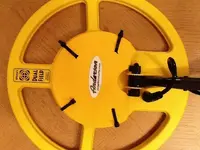It seems to be an approach - avoidance conflict. The heavier the coil, the more tiring to swing the detector on land, but then it floats in the water. The larger the surface area of the coil (With an Anderson coil weight system added) the more the coil is moved around by the waves. Hummmm.... There needs to be a weight system that you can easily put on and take off that adds minimum drag in the water and minimum resistance to wave action in the water to have the best of both worlds, if that is possible. I have noticed that with the spokes arrangement of the DF, I find that it has more drag than my Tiger Shark with its more solid and thinner coil, which seems to glide through the water. I don't think a rubber hose filled with water will work. Since water in the hose is neutral boyant with the water your coil is in and you are trying to get the coil less buoyant. You also don't want to add extra drag to the coil. I haven't done it yet, but I think the solution is to remove the coil from your detector and place it in water. Add non metallic weight like ceramic tiles to the top of the coil to see how much it takes to keep the coil down. Then figure out how many square inches of the tiles you added to get the coil to sink. Then decide which voids in the spider layout of the coil you can fill in to give you the weight in ceramic tile you need. Be careful about tying things to the coil since anything that touches the coil WILL rub against it and wear a hole in the coil. (I was fortunate I notices the erosion of the surface before I had worn all the way though and destroyed the coil.) I haven't quite figured out how to easily take the weight on and off so I haven't actually tried this yet, but it is the mental works....... Good luck with your project and let us know what you decide to do and how it works out. Blessings, Ralph





 I sure do love my Sand Shark.
I sure do love my Sand Shark. 


